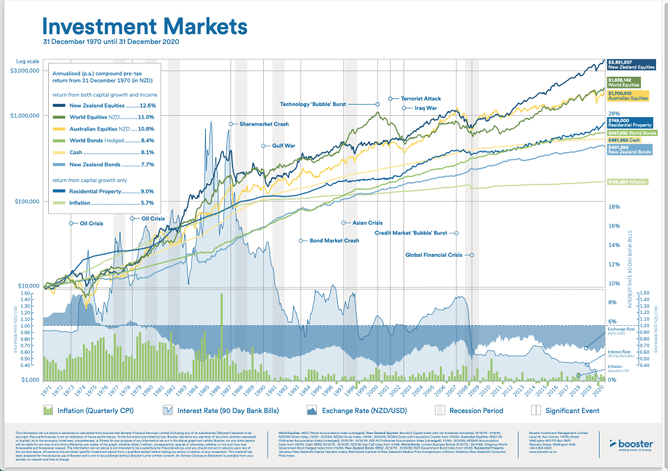Investment Markets graph - updated
From time to time fund managers put together a wallchart for their advisers to hang in our offices for clients to see what has happened in investment markets over time.
We feel that it is more useful for us to provide this to you to review and wonder over.
To download a copy of this PDF - see the link below
This wallchart, produced by Booster, one of our favoured KiwiSaver fund managers (particularly their Socially Responsible Investment KiwiSaver funds), is one of the best that we have seen.
1970 was the start of a major change in the global investment and economic environment (much as 2020 with Covid may be when we look at it in hindsight). The 1970's saw major cultural change, oil price escalation, wage and price freezes, and leading into the 1980's high inflation and sky high mortgage and deposit interest rates. Consequently it is interesting to see all of the last 50 years graphed out.
It is a busy graph, but take the time to look at it in detail as it is really informative.
For example, look at the 1987 Sharemarket Crash as circuit breaker in New Zealand. Proper to this there were interest rates well over 25% (pale blue filled in spikes), quarterly inflation spiking at 9% and the NZD/USD exchange rate around 40 cents.
Most relevant for long term investors are the coloured lines that increase across the chart. If you look at the thick blue line, you will see that despite the famous 1987 sharemarket crash (where there really were hollow or empty companies that didn't own anything other than 'air'), the market eventually recovered (but with real companies that made real things), and has had an average return of 12.60% pa compound pretax since 1970.
World Equities, Australian Equities have a similar trajectory - which is why the adage - it is time in the market, not timing the market - works. Our clients have been rewarded by staying in the market even when their human emotion is to panic and sell, long term investing works.
Take time to look at this, and if you have any questions or want to discuss this with your adviser, contact them in the normal way.


